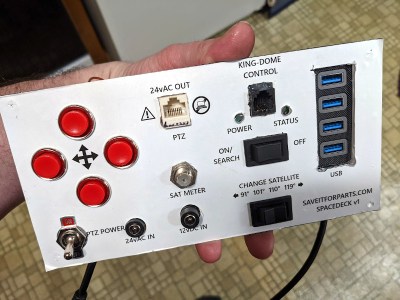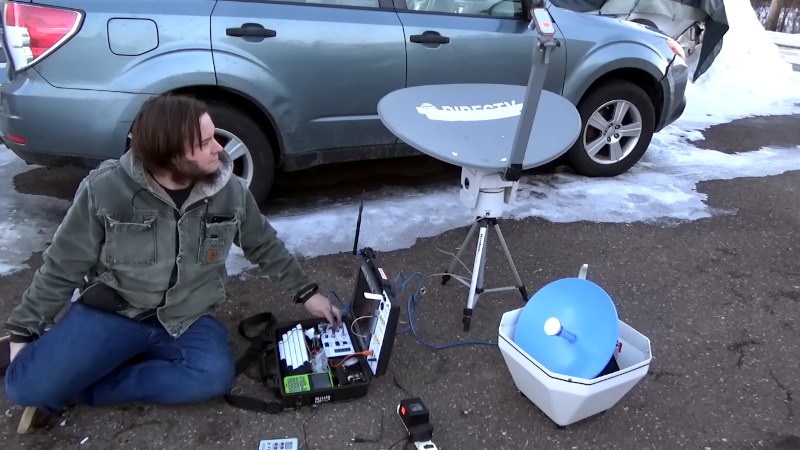While there’s little in the way of hard rules dictating what constitutes a cyberdeck, one popular opinion is that it should be a piecemeal affair — a custom rig built up of whatever high-tech detritus the intrepid hacker can get their hands on, whether it be through trades or the time-honored tradition of dumpster diving. It should also be functional, and ideally, capable of some feats which would be difficult to accomplish with a garden variety laptop.
If you’re looking for an example that embraces these concepts to the fullest, look no further than the Spacedeck built by [saveitforparts]. Combining a touch screen all-in-one computer pulled from a police cruiser in the early 2000s, an RTL-SDR, and the contents of several parts bins, the rig is designed to work in conjunction with his growing collection of motorized satellite dishes to sniff out signals from space.
 As you can see in the build video below, the design for this mobile satellite hacking station was originally very different, featuring considerably more modern hardware with all the buzzword interfaces and protocols you’d expect. But [saveitforparts] couldn’t get all the parts talking satisfactorily, so he went in the closet and dug out one of the surplus police terminals he’d picked up a while back.
As you can see in the build video below, the design for this mobile satellite hacking station was originally very different, featuring considerably more modern hardware with all the buzzword interfaces and protocols you’d expect. But [saveitforparts] couldn’t get all the parts talking satisfactorily, so he went in the closet and dug out one of the surplus police terminals he’d picked up a while back.
He didn’t have the appropriate connector to power the machine up, but by cracking open the case and tracing out the wires, he figured out where he needed to inject the 12 V to get it spun up. From there he installed a new Mini PCI WiFi adapter, loaded up an era-appropriate build of Linux, and got the standard software-defined radio tools up and running.
What really sets this build apart are the two custom panels. The top one offers access to the various ports on the computer, as well as provides a sort of switchboard that connects the RTL-SDR to various onboard filters. The lower panel includes the hardware and controls necessary to aim different styles of motorized satellite dishes, as well as a USB hub and connector that leads into a commercial satellite meter tucked into the case.
At the end of the video [saveitforparts] demonstrates the various capabilities of the Spacedeck, such as the ability to pull in imagery from weather satellites. Considering the sort of satellite sniffing we’ve seen him pull off in the past, we have no doubt this machine is going to be listening in on some interesting transmissions before too long.
















1. Where’s the hack?
2. Could use a 555
3. I got nothin’ this is supremely rad
3…all day long..3
He calls usb hubs “splitters”
Half the USA population seems to call them that. Cable splitters, USB splitters, Ethernet splitters…
Even the search engines return correct results when looking for them.
” s’what it does, y’all…”
Ask a random person anywhere what the difference is among a hub, a switch, a router and a modem, and you most likely won’t even get an answer: just a blank stare.
In fairness, by Ethernet standards a USB hub should be called a USB switch…
A USB hub does not switch. Only the Controller negotiates bandwidth slices. That makes it much like a hub, by ethernet standards.
Lol he called the shit poop!
Phone home
You can get shit if you slack on descriptions. Out west, Big tech.
Well, if we can do this for satellites then we can certainly snoop the signals coming from spy balloons to track them.
Here’s the bad idea:
Multiple ground stations could triangulate then feed target data to a capture vehicle crew. Contract with a Large and Dangerous Rocket Ship launch team to get gliders to an altitude above the balloon, then steer them into the target. Glider payloads would consists of a single decertified 100’ diameter cargo parachute (G-11 series) and a simple grapple assembly.
After several gliders have successfully attached themselves to the target and deployed their chutes a final glider would puncture the balloon and entangles itself in the fabric, then deploy a single smaller chute to act as a drogue for the others.
Reports said the whole spy balloon assembly weighed less than 1000Kg so you’d only need 1 successful attachment of a cargo parachute. Three would give you redundancy and a higher likelihood of the target surviving the landing.
I have about 50% confidence this will work, and 100% confidence it will kick off an international incident.